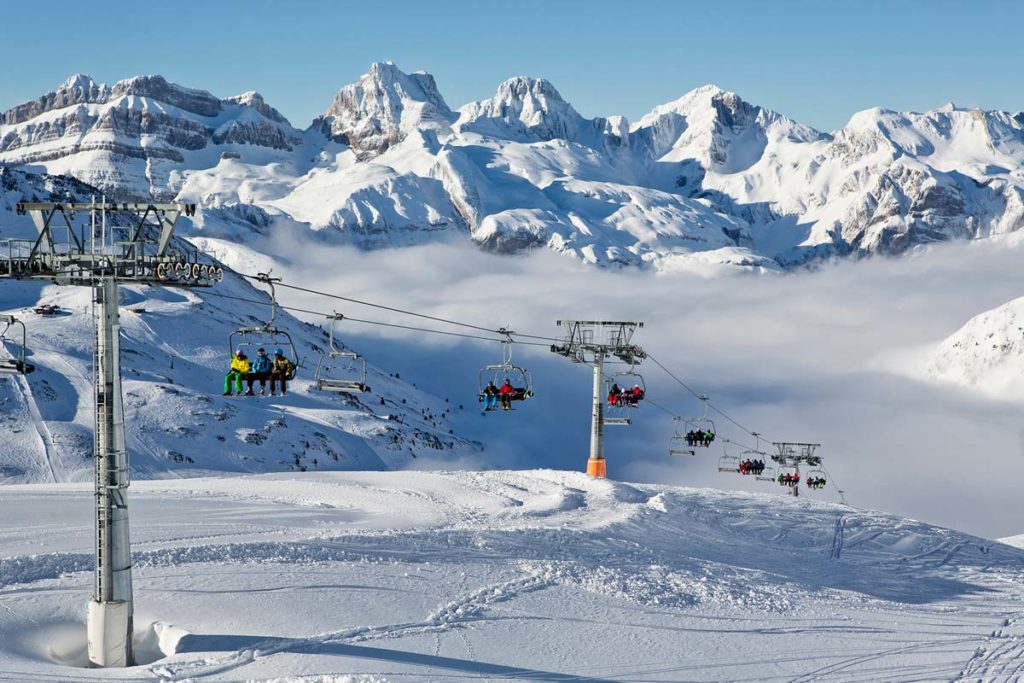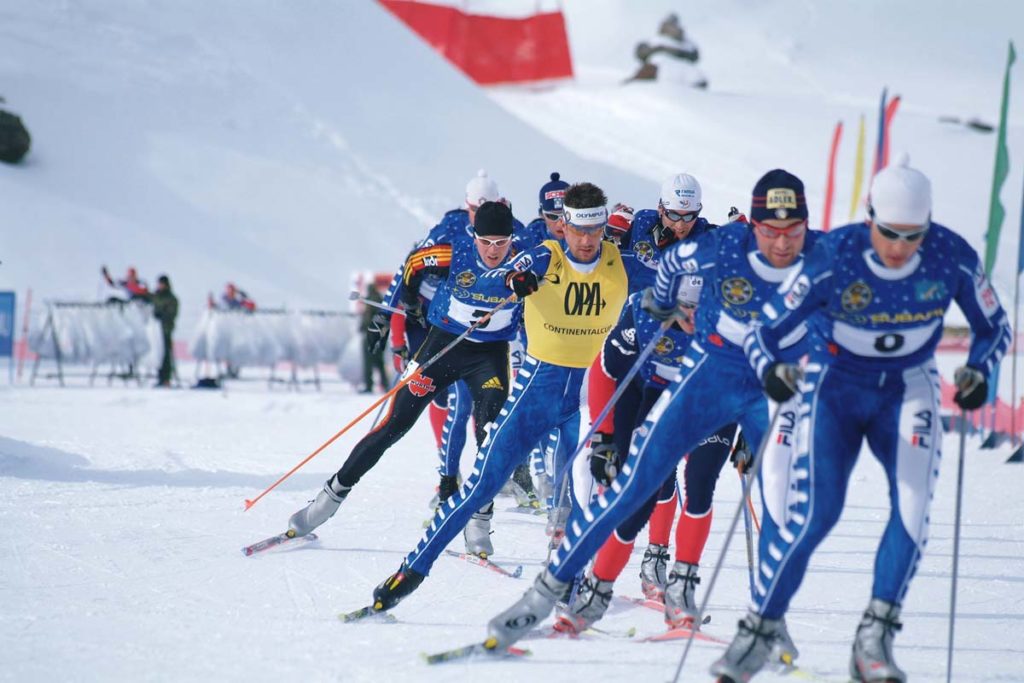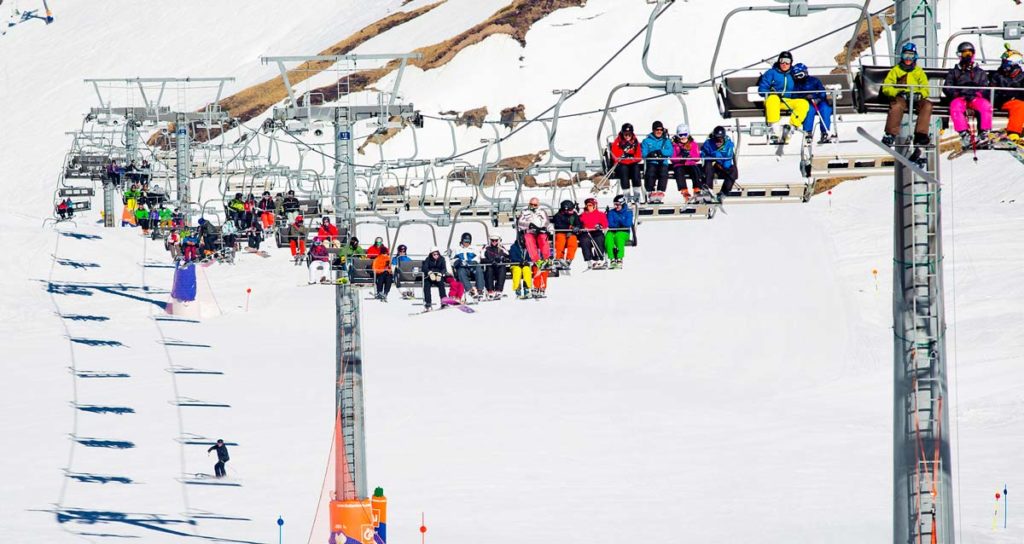Aragón = Snow
More than 400 kilometres of ski slopes spread over six resorts make our community one of the country’s main skiing resorts. Either on the slopes of the Pyrenees or in the mountain range in Teruel, Gúdar-Javalambre, the beacons mark the path to be followed, on some occasions dizzying and on others gentle. Snow, sport and leisure come together during these months to provide the most diverse and intense pleasures.
The first flurries
The figures speak for themselves: Aragon is one of the tourist winter destinations par excellence. The first flurries of snow bring with them an incessant trail of lovers of skiing, mountains and any other activities that require having an endless white mantle that bathes summits, plains and slopes.
Astún and Candanchú in the valley of Aragon, Formigal-Panticosa in Tena, Cerler in Benasque and the Teruel resorts of Valdelinares and Javalambre, attract the attention of an increasingly numerous public, from the youngest to those who think that “it is never too late to start.”
But in addition to skiing, the snow offers many other alternatives: sleigh rides, discovering remote spots on snowmobiles and walking in snowshoes are just some of the options that the Aragonese winter offers. And to round off a wonderful stay, the main areas, both in Huesca and Teruel, provide a complete infrastructure suitable for all audiences and pockets.
A thousand sensations below zero

Skiing is still the undisputed king of the snow, but gradually a retinue of other disciplines are not far behind, both sporting and recreational. And the fact that there are as many options as requirements with which to complement or replace a day’s skiing means that there is a myriad of alternatives available to satisfy all your needs.
The French baptized it “après ski”, a term that defines what remains to be done after skiing, and both the nomenclature and the meaning has been exported to all the winter resorts throughout the world.
There are many other alternatives to end a day in the mountains or to leave aside downhill events to get the most out of the day with other activities. The Pyrenean mountain range on its way through Huesca, one of the white epicentres in the county, favours practically all possible options. Night skiing, snowshoeing, cross-country skiing, off-piste skiing, sleighing, skating, snowmobiles, all-terrain routes, snow bikes… a thousand experiences bestowing so many sensations.
If winter brings with it these and other joys, simply enjoy what the snow makes available to those who come to it.
Lacuniacha... in snowshoes
Next to the small village of Piedrafita de Jaca, in the Tena Valley, this wildlife park not only concentrates its activities in the summer months but can also be visited in the winter. And nothing better than to do it with snowshoes along the trails that give life to this animated forest. At a height between 1,300 and 1,500 metres, the most enchanting animal species wait to be observed in their natural habitat. Pyrenean mountain goats, bison, wolves, lynxes and horses are, among others, some of the hosts that walk among birches, beeches, holly trees and oaks.
For two or three hours, depending on your speed, the adventurer can plunge into a totally wild, virgin environment to experience one of the most endearing sensations of the Tena Valley.
Sleigh rides
As if it were an Eskimo adventure, in the Pyrenees sledges offer breathtaking emotions. Nordic dogs as guides and professional experts to ensure the ride is all you need to get to know a wild land.
In the Tena Valley, you can practice for about an hour to learn how to handle the sledge and even combine sledging and snowshoeing. Without a doubt, an intense way of experiencing the Pyrenean winter.
Change skis for skates
The Jaca ice rink becomes for yet another year the focus of attention, providing fun for all the family. It has become one of the most frequented places after a day of skiing.
Other options
Leisure and fun also influence other equally pleasurable alternatives. Touring a magical spot in snowmobiles, flying over the highest peaks in the Pyrenees, diving under an icy lake, enjoying, of course, the affable gastronomy or a charming hotel, and focusing on cultural aspects, are some of the activities proposed by the winter environments in Aragon. For this reason, it only remains to get the ball rolling and decide which one is the most suitable.

Notes
The Aragonese ski resorts are centralized in four different locations, valleys and regions that during the winter months become a reference point for not only lovers of snow sports, but for any motivated and restless traveller.
Valle del Aragón
This Pyrenean valley has Jaca as its main tourist centre. It offers thousands of attractions ranging from artistic jewels as impressive as San Juan de la Peña or Canfranc station, to geological formations from the exciting Güixas cave, or settlements such as Villanúa, and Jaca, among others. A complete tourist infrastructure to satisfy the demands of any traveller. More information at www.valledelaragon.com.
Valle de Tena
Amid summits, slopes, Pyrenean lakes, streams and small villages, the Tena Valley is still one of the most frequented valleys in the Pyrenees. Panticosa, Sallent de Gállego and El Pueyo de Jaca are just some of the places you should never overlook on a journey through this magical place. Gastronomy, sport, adventure, culture and architecture are the bases of the rich heritage of Tena that, surely, leaves nobody indifferent. A world of sensations in this Central Valley that is active during the three hundred and sixty-five days of the year. Visit www.valledetena.com to learn everything about this imposing landscape
Benasque
The valley of Benasque, located in the heart of the Ribagorza, is one of mountaineers’ and hikers’ favourites as is the Pico Aneto, the highest peak in the whole Pyrenees, the Maladeta massif or Posets, among others. Hiking, climbing, paragliding and other adventure sports attract a good number of people throughout the year. In the town of Benasque, its capital, you must stop off to visit places like the 13th-century church, the Palace of the Counts of Ribagorza, the Plaza Mayor or the tower of Casa Juste.
Gúdar-Javalambre
The snow in Teruel centres around the region of Gúdar-Javalambre with a long list of tourist resources. Dive into the history of Mora de Rubielos and Rubielos de Mora through its palaces and squares, discover a tasty traditional cuisine, stroll through dreamy itineraries and, of course, enjoy the pleasures provided by the snow are just some of the options offered by region of Teruel. At www.javalambre.com and www.sierradegudar.com you will find an extensive directory of everything related to this area, full of scenic contrasts and tasty culinary benefits. Do not miss details of festivals, spas, and rural tourism that spread across and are organized in Gúdar-Javalambre. They are very worthwhile.
Other types of skiing
In addition to Alpine skiing, there are other disciplines such as cross-country skiing, also called mountain skiing, Telemark or snow surfing known as snowboarding. Find out what each one of them consists of.

Cross-country skiing
Nordic skiing is a simple and accessible modality consisting of traversing on skis some established circuits, generally flat, with slight rises and descents. It does not differ much from Alpine skiing as far as equipment is concerned, but the main differences are the skis, which are narrower and more pointed, the fixings, adjusted at the front, and the boots, which are low and flexible. It can be practised in any of the mountain areas of Aragon: Fanlo – Valle de Vió (Fanlo), Linz (Anso), Lizara (Aragues del Puerto), Oza- Gabardito (Echo), Pineta (Bielsa), Llanos del Hospital (Benasque), the spa at Panticosa (Panticosa) and La Muela de San Juan (Sierra de Albarracín)
Off-piste skiing
This is the modality that combines mountaineering and skiing whose skis are designed as a tool to reach the summit and descend freely by a route improvised by each mountaineer. It enables you to advance in deep snow without sinking. For this purpose, the skis have seal skins on the surface that adhere to the snow, which make it possible to advance gradually on the slope. Once at the summit, these materials are released to make a descent very similar to Alpine skiing.
Telemark
The Alpine skiing that we know today came from this discipline. The fixings of the skis leave the heel free thus combining off-piste skiing and the Nordic method. When starting to ski, the first notions are how to learn to wedge turn and become familiar with the fastenings as the attachments only adhere to the front of the boot. From there, a half-bending position is adopted to focus the weight and thus achieve the greatest possible stability. It is certainly a peculiar form more like a dance with perfect movements.
Snowboard
The last form of gliding down a mountain. Instead of two, we only use one ski made out of materials such as carbon or kevlar, from which protrude two almost parallel fixings. Snowboarding has several peculiarities very similar to surfing, the funboard or skateboarding. The environment of this modality has brought with it many terms that define styles, zones or acrobatics so words like freeride, snowpark, handrail boardercross are already part of the language of the addicts of this doctrine.
Aragonese resorts
Six are the Aragonese resorts devoted to the king of winter sports: Alpine skiing. Four are in the Pyrenees in Huesca and two in the Sierras de Gúdar-Javalambre, in Teruel: Astún, Candanchú, Formigal-Panticosa, Cerler, Javalambre and Valdelinares. They are names that soon are associated with skiing and that attract the attention not only of the Aragonese but of other skiers coming from most parts of the country. Discover the peculiarities of each one, the novelties, services and other details.
Without a doubt, the tourism in this community is inexorably linked to snow, one of the most attractive resources in all Aragon. A world of sensations that come with the first snows and that stay in the retina throughout the year.

CANDANCHÚ
Surrounded by high peaks, under the protection of the winds, the first ski resort in the country, it is also the largest skiable area in all Aragon with 58 kilometres of marked pistes. In addition to Alpine skiing, Candanchú offers Nordic walking tours, thus extending its coverage and organization.
The constant influx of skiers during the winter season and the celebration of various competitions demand of the experienced ski resort of Candanchú maximum dynamism, holder of Q certification for tourist quality awarded by the Spanish ICTE in 1999 and renewed in 2001.
Names like Pista Grande, Tobazo, Tuca Blanca, Tortiellas or Zapatilla form the network of pistes and routes across its 58 skiable kilometres.
Candanchú village is adjacent to the slopes so you can directly access the ski lifts leading to the resorts, summits and slopes. It has all the necessary services to complete an intense day of skiing, whether Alpine or cross-country skiing since it has Nordic circuits.
The fact that Candanchú holds the record for being the oldest national resort serves as a guarantee to fully enjoy a day in the snow. It certainly represents a magnificent site for unlimited enjoyment.

ASTÚN: The latest in snowboarding
In addition to its track record in Alpine skiing, Astún has opened up new horizons with the creation of a snow park, an area for winter surf lovers which is the main centre in this season.
In April 1970 several forestry engineers came together in Astún to start work on creating a ski slope that six years later witnessed how that pioneering project came to fruition with the launching of the current resort.
At the French frontier and 30 kilometres from Jaca, Astún is set out in a west-to-east orientation which serves to avoid strong currents of air and excessive sunshine keeping the snow in perfect conditions.
A snowpark designed for snowboard lovers has been added to the infrastructure of this enclave that includes, along with the slopes, among others, a ski jump. There, the half-pipe serves as a frame for performing incredible jumps and impossible pirouettes.
Astún has thrived with the passage of time to accommodate all types of skiers with facilities for all tastes.
Aramon FORMIGAL-PANTICOSA: in the heart of the Tena Valley
Skiing in the Tena Valley, almost verging on the French border, comes from Formigal and Panticosa, which today form a single resort. Its capacity, infrastructure and services put it in the sights of many skiers who find in its pistes a white world full of dizzying sensations.
Formigales, the Aragonese resort with the largest skiable area, is located at the end of Sallent de Gállego and reaches a maximum height of 2,200 metres. It was created in 1964 and since then has never ceased to seduce skiers and adventurers. This winter resort brings together other important activities such as night skiing, an extremely inviting activity, which extends its capacity for greater enjoyment over a longer period.
Panticosa is one of the veteran Pyrenean resorts, with more than 30 years of history, whose constant evolution has resulted in a substantial improvement of services and facilities. It represents a great option for the practice of Alpine skiing and snowboarding, among others, with a network of slopes in which moderate slopes coexist with other steeper ones.
It is one of the resorts preferred by families and a reference point for adults and children. Panticosa, village and resort, share the spot from where the ski lift departs and flows into the main area of the resort. From there, branches lead off to the valley of Sabocos, to the Petrosos area and to many other areas with a complete network of drag and ski lifts.
Aramon CERLER: The Valley of Benasque
In the municipality of Benasque, amid peaks exceeding three thousand metres, the white slopes of La Gallinera, the highest elevation, and their adjoining summits outline the layout of the winter resort of Cerler, one of the most imposing of those existing in Aragon due to its altitude and landscape.
Forty-five pistes accessed by seventeen ski lifts, including chairlifts, teleskis and conveyor belts cover a skiable surface of 52 kilometres. The story of Cerler began with its construction in 1970 and in its more than 30 years of existence has managed to find its place within the universe of winter resorts that the Aragonese Pyrenees offer.
To cope with this enormous demand, the resort has a capacity that exceeds twenty thousand skiers spread across the various sectors such as Cerler or Ampriu. Blue, green, red and black pistes serve as a multi-coloured fan down which to descend offering greater or lesser difficulty from the 2,630 metres of the highest elevation, to the 1,500 at the starting point. To counteract the mild winters, Cerler has a complete system of artificial snow to ensure perfect and profitable skiing.
These are sufficient arguments for going to Benasque and, from there, glide along the beaconed pistes of Cerler, or practise the vast number of winter disciplines offered by both the resort and the valley.




